#evocative names for abstract things
Explore tagged Tumblr posts
Text
Ok, the above is obviously low key dystopic but at the same time I do love an informal or metaphorical theorem name, like the ham sandwich theorem (given any n regions in R^n, there exists an (n-1)-plane bisecting all three) or the shoes and socks lemma, i.e., (f ∘ g)^-1 = (g^-1) ∘ (f^-1).
You guys know the squeeze theorem, a.k.a. the sandwich theorem? The one where if you have 3 functions that satisfy:
g(x) <= f(x) <= h(x)
And the following is true (as x approaches a):
L = lim g(x) = lim h(x)
Then (as x approaches a):
lim f(x) = L
Well it just clicked for me that in my Eastern European country, we call it "the two policemen lemma". Imagine how much of a police state it must be, that people see a line squished between two other lines and think: "Damn, another enemy of the state..."
11 notes
·
View notes
Photo

Norse-Viking Symbols & Meanings
A symbol is an image or object which represents an abstract concept, often having to do with one's religious beliefs. Every civilization, from the most ancient to the present, has made use of symbols to make the abstract concrete and visible and to provide assurance that a higher power was interested in, and sympathetic towards, the struggles of human beings.
The symbols used in Norse mythology had to do not only with supernatural entities but also with the challenges of everyday life and the mystery of what awaited after death. Some of these symbols can definitely be dated to the Viking Age (c. 790 - c. 1100 CE) but were no doubt in use much earlier. Other symbols seem to have developed later (between c. 1100 - c. 1300) after Christianity had established itself in Scandinavia.
There were many powerful symbols from the Norse-Viking period ranging from the wolf (for protection), to the horse (protection in travel), the troll cross (an amulet that protected one from trolls), the image of the Vegvisir ('way guide', a late Icelandic symbol which helped one find one's way) and the Web of Wyrd (web of fate), as well as the runes which were thought to evoke mystical powers. Generally, however, ten symbols were the most popular; these appear most often in stories, images, and as amulets:
Yggdrasil – the World Tree
The Valknut – Odin's Knot
The Swastika/Sun-Wheel
The Aegishjalmur – Helm of Awe
Mjolnir – Thor's Hammer
The Sventhorn – Sleep Thorn
Gungnir – Odin's Spear
The Ship
Huginn and Muninn – Odin's Ravens
The Triskelion – Odin's Horns
These symbols sometimes are found in the form of amulets (such as Thor's hammer), sometimes in depictions of the afterlife (as with the ship) and often in images concerning the journey of life (the swastika/sun-wheel and ship). In whatever context they appear, it is clear they were considered important evocations of powerful supernatural elements.
The Norse religion was non-exclusive and so it is common to find Christian symbols such as the cross paired with a popular pagan symbol such as Thor's hammer. Jesus Christ was initially considered just another god one could count on for protection and direction in life and remained so until Christianity became the dominant faith and the old beliefs died out.
Yggdrasil
The image of the World Tree appears in the mythology of many ancient cultures as a symbol of connection between all things and the cyclical nature of life: nothing ever finally dies, everything is constantly in a state of unending – and natural – transformation. According to scholar H. R. Ellis Davidson, Yggdrasil is "one of the most powerful symbols in Norse mythology, said to stand at the centre of the worlds of gods and men" (Myths and Symbols, 23). The nine realms of existence – all the seen and unseen worlds – were nestled in its roots including Jotunheim, the giants' realm, where Mimir's Well of Wisdom lay.
Although there remains much debate on the issue, it is generally agreed that Yggdrasil was an ash tree and that its name means "Odin's Horse" as in the tree to which the highest god's horse is bound but could also mean "tree of terror" as it is the tree on which Odin hung when he sacrificed himself to himself in his quest for wisdom (Simek, 375). The death-dragon Nidhoggr gnaws at the tree's roots while the eagle of discord nests in its upper branches and a squirrel named Ratatoskr runs up the trunk and back down delivering messages between the two. The dragon, eagle, and squirrel are all symbols of change as not even Yggdrasil will last forever. In the final battle of Ragnarok, the twilight of the gods and end of the world, Yggdrasil will be destroyed along with everything else but will be reborn afterwards in a new world.
Continue reading...
38 notes
·
View notes
Text
inspired by krissy i want to talk about those sweet sweet original characters

it'll get long let's go...!
oh before i get into it you're gonna see a bunch of art throughout this that i've steadily been commissioning for years from @seeyouguyslater! they have a really keen eye for design from description and a dynamic, evocative style that lends itself well to pinning down visuals for characters who don't have anything more than a text description and a few reference images or picrews.
i'm gonna break this up by setting since i tend to think in terms of places and then build out characters from there so:
THE BOUND GODDESS
this is a fantasy setting that's been a loooooooong ongoing project between myself and @kc5rings that is the subject of a novel's worth of note-taking and two tabletop games (so far). the quick pitch is that it's a story about divine betrayal, divine love, the well-deserved implosion of an expansionist empire, and a lot of girls with really rotten luck. I'm only going to get into it about my own characters here for obvious reasons but go bug kat about theirs too!
Arcadia & Avalon

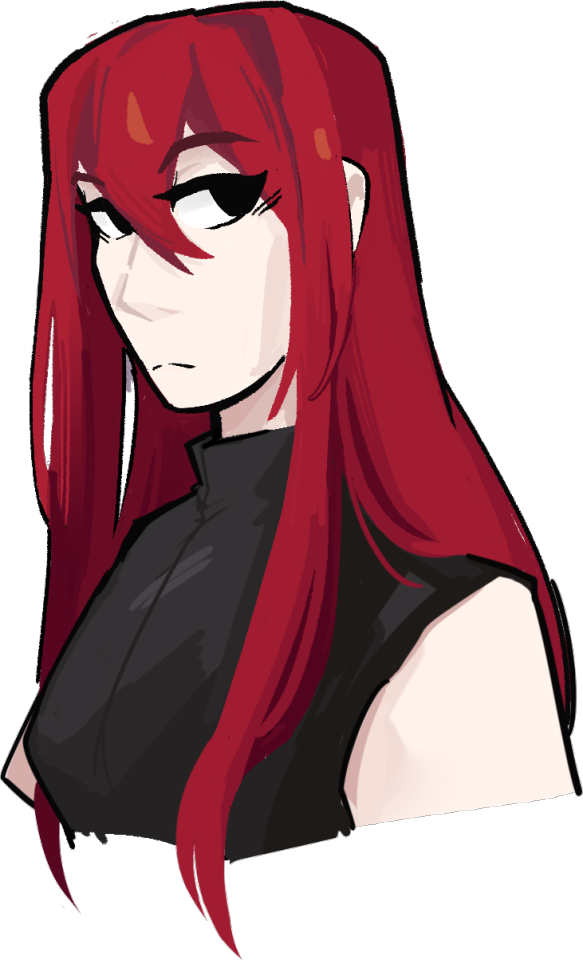
Arcadia is fate's chewtoy. She's also the sword of a creator-goddess (one of six divine instruments), fallen to the world to wander when the goddess was betrayed and bound by the myriad other gods. She's a sword in the sense of a sword of office, a sword of selection, and sometimes like a misericorde. She doesn't really relish any of these roles, since she has ages of experience with the things people do with them. Day to day, she's a jumpy, meticulous woman with an endless array of skills from her long years spent wandering and hiding in plain sight among humans. You're much more likely to meet her as an innkeeper's assistant or a baker's new hire than anything as grandiose as what she actually is. Please for the love of god be nice to her.
Avalon is one reason why you should be nice to Arcadia! She was the goddess' *other* sword, and is less about abstract concepts and far more about abrupt lethal violence. In the ages since the goddess was bound, not a single human has wielded Avalon, because even deep in dreams about the life she lost back then, Avalon cuts anything that gets close into ribbons. When one of her sisters is in danger, Avalon wakes for long enough to find and free them by the most direct means possible.
Lieutenant Chyr & Normal Secretary Sylvie


Chyr and Sylvie are citizens of a big shitty expansionist empire and members of its military! Kinda! It's complicated! Chyr nearly died when she was a kid and was saved by a VERY experimental procedure that partially fused her with a bat! Her big-ass ears are getting cut off by the image cropping. Being part bat has its upsides and downsides, especially in the kinda unstable prototype state she's in, and any time she's injured (frequently) her wounds heal with more batlike features instead of scarring. Patches of fur, single claws or fangs, that sort of thing. She's serious, loyal to a fault, and a part of the group that will eventually rip the empire apart from the inside.
Sylvie's just a secretary! Really! He's part of the same faction Chyr is and was also fused with an animal (a rabbit in his case) for complicated reasons that boil down to keeping his family out of the sights of a vindictive oligarch. He's a much more stable combination of person and bunny and doesn't suffer many of the drawbacks that Chyr deals with. He's also a secretary and lethally pretty! He's never not crossdressing and typically rocks the white blouse + black pencil skirt combo. Sylvie is sharp as a tack and knows exactly the effect he has on people; often he covers for this with a half-genuine scrambling flustered demeanor.
There are WAY more characters in this setting but honestly I could do several entire long-ass posts about it and that's not what we're doing here SO
SCI-FI SETTING WITH NO MECHS IN IT I HAVEN'T NAMED YET
look okay i love mecha we all love mecha they're big impressive evocative and all around cool. BUT. i also often feel like you lose something in a sci-fi setting when you put mecha in it because then it becomes *about* mecha in a way that's hard to shake. i started assembling this setting because i watched a bunch of legend of the galactic heroes and went man you can do some really cool stuff when it's all just ships planets stations and people. I haven't commissioned art for anyone in this setting yet but you bet your ass i plan to
Solo Sequentia
A mysterious figure in long, heavy robes and a wide-brimmed hat nearly big enough to completely hide their face. What if Siffrin from in stars and time were even more committed to not having an inch of visible skin. The name is a pseudonym (i'm not quite that committed to silly thematic names when it's a moderately serious setting), made appropriate by their weird-ass situation.
Solo Sequentia has a problem, which is that they can't die. Or more specifically, they *can* die, but each and every time they reawaken in bed in a studio apartment attached to an otherwise sealed facility just beyond the edge of the galaxy. In their search for answers (and possibly, a way to die for good) they lie, cheat, steal, manipulate, scheme, and sabotage their way across every inch of civilization.
ENSIGN 0 and the Ligature Squad
One of the key things of this setting is that it takes place in a galaxy split between three major powers, with big elaborate diplomatic maneuvering happening on the broad scale and endless back-and-forth territory squabbling between warlords at the borders between the three powers. At one point, one of the major factions kept a particular ace up their sleeve--a soldier beyond compare known only by the codename ENSIGN 0.

(an aside: a bunch of these glyphs and codenames and such are made with affinity photo and a bunch of fonts from a pack by YutaONE.)
ENSIGN 0 is sci-fi 60-something tragic dyke big boss. Her presence almost singlehandedly determined the course of the war for nearly a decade before she decided she'd had enough of being the secret weapon of a military she'd long since lost all faith in. No one who knows who she is has seen her since!
The powers who had used her as their killing implement du jour weren't about to take this lying down, and quickly moved to replace her--this time with a squad of robots they hoped would be easier to control.

That's Ligature squad babey!!!! Each of the six members is intended to replicate a portion of ENSIGN 0's skills. I actually did a little write-up about them ages ago, though they've changed a bit since then. To summarize:
Optic 1, sniper and infiltrator. Serious, quiet, often mean. Puts a lot of effort into never letting anyone know how she feels.
Sine 2, heavy ordnance specialist. Quiet and protective, never talks until she's already completed the thought in her head. Extremely funny when she feels like telling a joke.
Hound 3, close-quarters combat, flanker and tracker. Vicious, stubborn, and loyal to a fault.
Riptide 4, poisoner and saboteur. Charming, easy to talk to, hard to figure out. The cruelest of the bunch when she wants to be.
Tact 5, walking foundry. Tidy, polite, prone to getting flustered.
Rem 6, artillery specialist and tactician. Spends most days either asleep or in a dreamlike haze while she runs an unending array of tactical simulations. Snaps into dead serious focus when needed.
Surprise! They also didn't love being treated as disposable killing implements. They also disappeared on their creators, and now travel the galaxy working as mercenaries while they search for ENSIGN 0, who they think of as something between a mother, a mentor, and an inspiration.
I wonder how close to the character limit I am at this point.
CAPE CITY
this is where i have to make a confession. generally speaking, most of the time, i can't stand cape stuff. i see a superhero and i curl my lip into a sneer that would, thanks to the dread irony that rules my life, make me fit terrifically into that superhero's rogues gallery.
but.
BUT. i can't deny there's something really compelling there. urban fantasy making passionate love to professional wrestling. we could have it all and instead we mostly have a festering pack of racists, misogynists, and general old-boy's-club types shambling around in a pair of giant trenchcoats and all but smothering the genre in the process. it's usually around this point of rambling about it when i realize if i'm paying this much attention to it it must be because i care, oops.
so i made cape city! okay i say i made it but it's another collaborative one between me and kat. making stuff with kat is awesome. it's a loose freeform setting that boils down to what if there was a cool city where all the superhero/supervillain stuff happened. there are a ton of characters in this one that i wont get into in detail but to summarize a couple:
The Ballistic Boa (secret identity Aspen Lerna), a woman who got experimented on and is part snake now. She has a big cool tail, scales in some places, is VERY flexible, and has a pair of solenoglyphous fangs which have a venom that can kill anything. Like mystic eyes of death perception levels of anything.
Akida Ki, a psychic from a distant bad end future who came back to the past samurai jack style to save the world, but arrived to find that the crisis was already averted. Now she's just here and trying to figure out what to do next.
Judie, a career henchman, underling, minion, goon, whatever term isn't being used as an obnoxious marketing campaign or sex-negative pejorative this week. She's an eight and a half foot tall rabbit woman with several mechanical limbs and an absolutely unquenchable thirst for power and pleasure.
Kimera, an unfathomable creature wearing the shape of the human being it used to be. Loves to turn people into stuff and invented puppygirl HRT.
The setting is full of freaks like them and I could go on all day describing them but I want to focus more on two characters in particular:
Cold Comes Summer & Warm Sweeps Autumn


Remember how earlier I said I don't commit that hard to silly thematic names in serious settings? Well so okay this is not a serious setting. Rat girl Summer.
Summer is a villain! She's selfish, short-tempered, and hates her fucking family so goddamn much. Her family are a bunch of very type-moon style mages, and when she told them to fuck off and never contact her again she also swore off magic forever. Mostly. She's also a hypocrite. Instead she favors the classics of supervillainy--rayguns with a million knobs and switches, elaborate traps and devices, and the occasional Real Gun.
Autumn is a complicated case, and one deeply entwined with the nature of Cape City as a place. At the end of the day, the heroes and villains of Cape City all play a game. An elaborate, often dangerous, sometimes deadly game, but a game nonetheless. Games have rules.
Once, the person who would become Autumn was a hero's sidekick. Said hero was a bit of a ruthless sort, which is fine on its own, but...
But that hero decided to lay a trap for Summer with their own sidekick's life as the bait. Summer isn't a heartless rat and did all she could, but the sidekick was brain-dead by the time she arrived. Wracked with guilt and grief, she exhausted every avenue she could think of to try and bring them back--her own brand of mad science, Kimera's mastery of mutagens, the mental prowess of a fellow villain... even magic. After all her efforts, someone did, at last, wake up--but not the person she'd been trying to save. That new person became Warm Sweeps Autumn, and a motherfucker of a superhero got what they deserved.
Which brings us to Autumn! Yay! She's a big (6'11") soft great pyrenees woman with a heart of gold and a pair of big fuckoff gauntlets she grapples heroes with. Summer's best (and only) dedicated minion, she's nearly indestructible physically and completely indestructible mentally. Summer isn't about to let that happen again.
Completely Normal Secretary Sylvie

Secretary to a well-reviewed therapist in Cape City, Sylvie is,
wait
whadda hell...?
17 notes
·
View notes
Note
hello. love what you do!! I'm writing a script set in mesopotamia and was wanting to use words from the language to name my characters. not names that they actually used then but just words that link to their personalities.
would you be able to translate any of these?
- argument or fighter
- fate or destiny
- care or love
- purity or good
-thoughtful or wise
thank you so much!!
Hello, and sure thing! Some of these I've translated before and will link, and the rest I'll do my best with below.
"Argument" is adamen, also meaning "fight, contest, dispute, debate", and is written with the very evocative 𒈓 or sometimes as 𒀀𒁕𒌋𒌋. For "fighter" I'd use one of the words for warrior from this post, probably ursang 𒌨𒊕.
"Fate" or "destiny" is nam 𒉆, see this post for a use in context. It's also a prefix (or noun root) that makes an adjective into an abstract noun, see examples below.
There are several verbs for "to care", the most specific being the phrasal verb mi dug 𒊩𒅗 "to care for, treat well, treat kindly". I don't know of a great example of "care" as a noun, though we could craft a noun like miduga "(act of) caring". See this post for "love".
"Purity" is namsikil 𒉆𒂖, from sikil, one of many words for "pure, clean." There are two basic words for good in Sumerian, dug 𒄭 and sag 𒊷 - the distinction between them is subtle, but I generally use dug for a more conscious or righteous good, while sag is more like a pleasant good. As a noun, we'd make them using nam: namdug 𒉆𒄭 or namsag 𒉆𒊷 "goodness".
The word for "thoughtful" is shakush 𒊮𒊨, also meaning "well-informed, well-advised." It's derived from the phrasal verb shag kush "to rest the heart, soothe, take council with, advise." "Wisdom" is namzu 𒉆𒍪, from zu "to know" (with that nam- prefix again), and is contrasted with ningzu "knowledge".
Thanks again for the kind words, and best of luck with your script!
21 notes
·
View notes
Text
Under scrutiny over his positions on Israel, the ascendant New York City mayoral candidate Zohran Mamdani declined to condemn the phrase “Globalize the intifada” while speaking on a podcast on Tuesday.
Asked by the host of “The Bulwark,” which bills itself as being for moderate liberals, what he thought about the phrase and another widely used at pro-Palestinian protests, “From the river to the sea,” that have been criticized as antisemitic, Mamdani denounced antisemitism but rejected the critique.
“I know people for whom those things mean very different things,” Mamdani said in the episode, released on Tuesday. “Ultimately what I hear in so many is a desperate desire for equality and equal rights in standing up for Palestinian human rights.”
“Globalize the intifada,” used widely used at pro-Palestinian protests, is seen by many as a call for violence against Jews. “Intifada,” which means “uprising” or “shaking off” in Arabic, was the name of two violent Palestinian uprisings including one from 2000 to 2005 that killed an estimated 1,000 Israelis in terror attacks, including on buses, at cafes and at recreational centers.
In recent months, as Jewish targets faced multiple violent attacks by people who said they were acting on behalf of the Palestinians, the phrase has faced renewed scrutiny. “When you repeat slogans like ‘globalize the intifada,’ you are inciting violence against Jews in the United States and around the world,” New York Rep. Ritchie Torres tweeted after two people were shot to death outside the Capital Jewish Museum last month. “The danger of incitement is no abstraction.”
After Bulwark host Tim Miller suggested that he shared concern about the phrases, Mamdani said he viewed “From the river to the sea” and “Globalize the intifada” as “super different … like different genres.” But he said he would not want to prohibit either of them.
“I am someone who I would say am less comfortable with the idea of banning the use of certain words,” he said. “And that I think it is more evocative of a Trump-style approach to how to lead a country.”
He also suggest that he thought the phrase “Globalize the intifada” was sometimes misunderstood, invoking a major act of Jewish resistance against the Nazis in the process.
“I think what’s difficult also is that the very word has been used by the Holocaust Museum when translating the Warsaw Ghetto Uprising into Arabic, because it’s a word that means struggle,” he said. “And as a Muslim man who grew up post-9/11, I’m all too familiar in the way in which Arabic words can be twisted, can be distorted, can be used to justify any kind of meaning.”
Mamdani, a state Assembly member and democratic socialist, is polling second behind former Gov. Andrew Cuomo in the Democratic primary, which takes place on Tuesday. He has drawn criticism from some Jews and pro-Israel voices over the course of the campaign over his record on Israel, which includes founding a chapter of Students for Justice in Palestine in college, supporting the BDS movement to boycott Israel, organizing a rally while in office to call for divestment from Israel, and saying he would not visit Israel as mayor. (Every mayor elected since Israel’s founding has visited.)
Mamdani, who would be New York City’s first Muslim mayor, has reportedly also taken heat from some on the left for being too soft on Israel. He has said Israel has a right to exist, though not specifically as a Jewish state.
His campaign has focused on progressive policy proposals for the city, including free buses and government-run grocery stores, that are seen as ambitious but likely impractical. He has also proposed diverting funds from the police department to a new community safety division that would tackle hate crimes, including against Jews.
“What we need to do is focus on keeping Jewish New Yorkers safe,” he said on the podcast. “And the question of the permissibility of language is something that I haven’t ventured into.”
5 notes
·
View notes
Text
My in depth reactions to the names and logos. First overall is: I don't hate any of the names. They're all okay. 🎉
Minnesota Frost: The name is fine to good. It's going to make a killer arena chant. "let's go frost" is three syllables so will avoid the sing song of four, and ending on a hard consonant? That's gonna sound goooooood in the X. It'll be like the "we want the cup" chant since we swallowed the third "the" syllable mostly anyway and damn it was a kick. @hsavinien also pointed out "killer frost, killer frost" which mmmm tasty. The logo is.... Okay. My main problem with it from an artistic standpoint is they gave it a long tail which is clearly making it a bitch to put on merch and stuff. It looks off center on a lot of things. They need to smush it up a little. But I'm not super worried about logos because those are more easily changed than names. I require a yeti mascot
New York Sirens: Sirens is neat for the ability for it to play on city noise, goal siren, and ferocious sea monsters. I know some people are cringing because of that last one because siren can be a little gross applied to women on a mythological level but uh, I'm here for owning the powerful man eating sea creatures. The logo is not awful. I think New York's text logo is the best one, that echo effect on it is cool. I'm less into the NY but idk it's growing on me. If their mascot isn't a rat mermaid they're wrong
Ottawa Charge: my other favorite team. Oh babies, what have they done to you. The name is fine. The logo is not. It evokes the Flames. It's kind of just awkward and abstract looking. It looks like a logo for a group home. I really liked their black and red, it did not need yellow. Uffda.
Boston Fleet: eh it's ok. I truly think Wicked and leaning into witches would've been cooler. Fleet is a generically interesting name I guess. The logo makes sense. to me it's safe, kind of boring, but inoffensive. Which is fine, and the vast majority of sports logos. I am glad I don't have to be tempted to get a Boston jersey like I would've if it was witches lol 😏
Montreal Victoire: RIP the pronunciation outside of Canada. Cool name though. Logo is a little busy for me but is evocative of a but of heraldry which is always neat and fitting (no one's jerseys are cooler than the German national team, for example.)
Toronto Scepters: the name is ... Fine. It is no longer problematic to women so that's good, but I feel like they went with a slightly more colonial than necessary team name. Scepters aren't unique to European culture, but combined with the logo and styling it does evoke that particular type. It is unique though. And Reign would've stung, because I know Minnesota will want to still casually use purple reign. I don't like the logo. I loved Toronto's clean blue and white, and that yellow is not it. I in general don't like that text logo style even though its classic. It also is just the St. Thomas logo with a holy hand grenade on the top instead of a shield, in worse colors. And as a Katie, mortal enemy of the Tommies, there's just a natural visceral dislike there. 😏 But it's not the torch. So. Win. 🎉
So, my Minnesotan based review: could be worse.
4 notes
·
View notes
Text
This is some great counterpoint by @fuckyeahisawthat, and is pretty accurate by my understanding. But it's not the whole story, and I wanted to add some nuance:
Visuality has always been important in television, from its inception. Directors, cinematographers, designers (of sets, costumes, etc.), actors, and producers all had a lot of creative ambition, and there was a widespread desire to outdo the competition, bring new innovations to the medium, and "make a name for oneself."
The people who produced TV's nonfiction stable of programming—including news, sports and athletic matches, and features (e.g. long-form interviews, educational content, documentaries and travelogues, etc.)—had a vested interest in the value and potential of their photography, visual demonstrations, onscreen diagrams, and so forth. Generally speaking, these aspects of nonfiction programming would have been deleterious for a viewer to miss out on. Not to say people didn't miss out (e.g. while making dinner), but they often did so at a penalty to themselves.
The people who produced fiction / entertainment programming for TV—e.g. dramas, sitcoms, horror and suspense programs, kids' shows, music programs, and theatrical performances of plays, music, etc. (some of which strain the container label of "fiction" and would better be called "cultural," but I'm keeping it simple)—also had a vested interested in making the most out of the new medium. Exciting, action-packed visuals helped hook kids. Thoughtful, evocative visuals around something like a symphony orchestra performance helped immerse viewers at home into the experience of actually being present in the auditorium—an "evening out" from the comforts of home, and at a much lower price. Shows like The Twilight Zone made clever use of shadows and abstractions to build horror and unease. And, additionally, "radio" wasn't the only progenitor of television: Other cultural sources were progenitive of it too, like stage theater, which had a lot of physicality that you had to see to fully appreciate, and vaudeville, which had a great deal of visuality in its humor and storytelling, and these progenitive sources were also reflected, where applicable, alongside the influences of radio when it came to their respective TV adaptations—and this was true right from the beginning.
Generally speaking, visual effects, visual gags, visual bits, and visual storytelling itself were all of great importance in fleshing out TV shows and specials. Imagine Lucy and Ethel on the chocolate candy conveyor belt line, or the gambler trying to light his lighter ten times in a row in Alfred Hitchcock Presents. One simply cannot miss elements like this and still claim that they have absorbed the storytelling.
So it's not quite right to say that early TV was designed to not have to be closely watched. Rather, the way I would put it is that early TV was (mostly) designed to be as accessible as possible to the casual viewer, i.e. the listener who might have over things going on at the same time—because why leave profitable audiences out of your televisual revolution if you can help it, and why make the switch from radio to television any harder than it needs to be? But, that said, television absolutely was designed with a visually attentive audience in mind, for the most part, right from the start. Hollywood knew what it had on its hands with the advent of television. They knew the visual medium was important, that it would fundamentally transcend what radio had been able to do. They were pushing hard into that exciting unknown. And let's also recall that television was a novelty in its early years and very exciting on a cultural level. People would go over to each other's houses to watch new episodes of their favorite shows, or watch the fights together, etc. Hollywood knew this too, and producers and directors were eager to take advantage of this enthusiasm to the fullest.
I said "for the most part" because there were exceptions, naturally. Some television really was produced to be primarily auditory. One of the biggest categories for this would have been "women's" daytime programming like the soap opera—which was designed with hardworking housewives in mind and in any case didn't have the time or budget for much visuality in its production. What visuality did exist was often there solely to entertain audiences with aspirational clothes, housewares, and pictures of idyllic midcentury life, and, complementarily, to likewise entertain them with the scandalousness of scoundrels. Another category in this vein would have been popular sporting events, which were very well-narrated on TV, with all the same care and attention to detail utilized by radio announcers, so that if a viewer at home wasn't able to be fully visually attentive they could still listen in and get a good sense of the action, and perhaps they could pay closer attention to the TV screen at moments when the action was especially interesting. And, as was mentioned, a third category of "audio-first" television would have been those TV shows that did hop over from radio. They carried the trappings of radio with them because they had formulas that worked and loyal audiences. These productions often had very little visuality except as set dressing. The 1950s incarnation of Dragnet is a good example of this that I can attest to. TV Dragnet was the televised version of its immediate predecessor of the same name on radio. (But consider that the times changed rapidly, and, just ten years later, the more well-known 1960s incarnation of Dragnet was already something of an anachronism in its terse speaking styles and punchy pacing (very radio-inspired). By the time color TV began taking over at the end of the 1960s, Hollywood was already mining deep into the world of visual potential with the television medium, and "make it so that you don't have to actually watch it" would have assumed an increasingly niche meaning, referring less so to the ethos of the entire production and more so to the aesthetic principle of not overcomplicating or overcluttering that still-tiny boob tube. Or at least that's my interpretation. I'm not actually a part of the television industry, and never was, so what do I know?)
But, to get back to the thread of my plot, even at the beginning of television, categories like the above were the exceptions. Visuality was always important. If that doesn't appear obvious to modern eyes, that's probably because of some conventions of the medium interfering:
The key problems with visuality in television took the form of two main challenges: small visual fidelity and small budgets (at least compared to motion pictures). The budgetary issue speaks for itself, so I won't dwell on it. But as for visual fidelity:
Early television had very little visual fidelity to play with—certainly nothing in comparison to the quality of the pictures that people would still regularly go and watch at the movie theater. Pictures were small, and many people's antenna reception was less than flawless to begin with. So the visuality that did exist on television had to be some combination of simple, bold, and familiar.
The boldness component had more to do with taking advantage of the limitations of the medium to innovate new forms of creativity that looked compelling in the medium. (I mentioned The Twilight Zone, for example, whose visual mood-building at times is vaguely reminiscent to me of very early film from decades earlier, when costumes and set designs often looked like they were out of paintings or dreams—the pioneers of motion pictures having likewise made the most of the severe limitations of their nascent medium to create astonishing visual ideas.) Meanwhile, it is the simplicity and familiarity components which allowed for a lot of television programming to be watched without actually being closely watched per se.
This simplicity interacted with the storytelling in some interesting ways. It's one of the lesser reasons that early television was so cautious, formulaic, and "staid" by modern standards in its camerawork. Interior establishing shots would usually showcase the visual forms that would become relevant in the course of a scene or program. Camera shots would linger for longer so that viewers had time to make sense of what they were looking at. (A sadly neglected bit of craftwork nowadays, as a lot of modern storytelling doesn't actually engage with its own elaborately-constructed environments, and doesn't really care about the realism or realness of those environments.) Similarly, upcoming visual effects / gags / etc. would often be lampshaded in the narration or dialogue ahead of time, and the rudiments of gags introduced or explained, so that audiences wouldn't be forced to identify objects and actions on the screen strictly through visual means. Moreover, in scripted programming it was commonplace for the plot and the action to run heavily through the dialogue, as was mentioned in the previous post (and also through the sound and foley work, which was often done very thoughtfully). And, thus, through simplicity there was a certain amount of redundancy and accessibility built in so that it was possible for audiences to make sense of what was happening, to an extent, without actually seeing it. Some television programs were more forgiving about this, having simpler set designs, less visual storytelling, fewer visual effects / gags / etc., and simpler soundscapes than other programs. Even in prime-time programming this wasn't rare; you could pick a scene at random from something like, say, The Donna Reed Show, and probably still be okay in following the action even if you didn't look at it whatsoever. But such programming made these concessions at its own expense, and most of the classics, which have stood the test of time, do not fare as well under such lack of scrutiny by the viewer: You just can't ignore the visual dimension of I Love Lucy or The Dick van Dyke Show, etc., and not be seriously penalized for it.
But even shows like those, which weren't as simple in their visualities as their less-illustrious contemporaries, were more forgiving than a lot of modern television programming. How? That's where the familiarity component comes in. Shows like these, and a great deal of television programming in general, benefitted from being familiar to audiences. Recurring shows such as sitcoms and dramas, with familiar characters and almost entirely familiar scene locations, could be watched less closely and still appreciated uncommonly well due to the audience's prior knowledge of the functionality of these familiar stage sets and the visual performance styles of the actors. Even beyond individual productions, this helped to crystallize entire genres of television, with audiences building inferred expectations about what a given type of show was supposed to entail. And this adherence to formulas and tropes was done faithfully by Hollywood, making it much easier for viewers to look away from the screen for a bit and return without getting totally lost.
But by the time I came on the scene, in the '80s and '90s, watching a TV show without watching it wasn't really a thing for the most part. You could do it with some niche programming—I used to like to run The Weather Channel in the background sometimes—but, for the most part, if you tried to watch, say, The Simpsons, or Home Improvement, or Yan Can Cook without looking at the screen...you were missing out on a lot, to the point where you would struggle to follow what was actually happening and/or fully appreciate the humor and storytelling.
That's more or less everything that I wanted to say. Television was visually ambitious and intrinsically visual right from the beginning, despite also being highly accessible to listeners and perhaps "modest" to our modern eyes.
It's fascinating how some of these conventions of listenability survived for so long, with the previous poster mentioning that the associated principles were still being taught at least as recently as the beginning of this century. It's definitely true that, specific to this century, a lot of high-end television programming has moved away from its television roots and toward the paradigm of motion pictures. That was not a thing in the 1990s; you can basically track it back to when widescreen TVs took over 4:3 sets as the default.
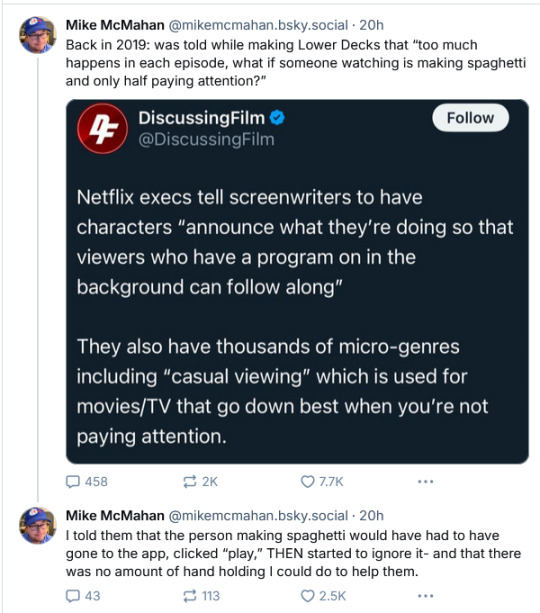
#Early television#History of television#Philosophy of Television#Classic TV#I Love Lucy#The Twilight Zone#Alfred Hitchcock Presents#The Donna Reed Show#(I wonder how many people in the entire remaining future of humankind are ever going to search tags for The Donna Reed Show.)#Television production#Midcentury culture#Television industry
67K notes
·
View notes
Text
Reading 2 - DADA & Photomontage
Dada is an art movement that was brought up in a little nightclub named Cabaret Volitaire in Zurich Switzerland, this was mentioned in the, "Dadaism in 8 Minutes: Can Everything Be Art?" video. A group of artists moved to neutral Switzerland and formed a new artistic group called, DADA. It was sought as an anti-art movement that went agaist traditional artistic values, it embraced chaos and randomness in a way with all of the societial structures in place that was causing destruction around the time.
The movement went against the rules and paved their own way of ideals, as they aimed to destroy what was thought of as acceptable.
At the core of Dada artists' beliefs or motivations were a rejection of societial norms and tradition, using what was normal to go against and critique war, politics and establishments.
They expressed these ideas by creating art like photomontages, ready-mades, out of the ordinary art, and satire, rejecting artist rules and logic.
I see DADA's influence today by it breaking the boundaries of art, opening up new avenues of mediums, challenging what society defines as art, and the irony to critique modern issues.
The first DADA artist that was presented, was German artist Hannah Hoch, mentioned in the first video, "Cut with the Kitchen Knife". Hannah pushed boundaries in art, hence breaking rules by capturing the political chaos during that time, cutting a swath and putting the pieces to put things back together. She was focusing on fragmentation as defining culture in that moment of time, as this reinvented photography through photomontaging, from magazines, mass media, and more. Her work also addressed issues towards gender inequality, as it was shown in "Cut with the Kitchen Knife, including photos of independent women while putting awareness on underaddressed ideals of feminity. Her meaning in imagery was to highlight the chaos and contradictions of post-World War 1, political corruption, and gender roles. Her symbolism had a lot of women, emphasizing instability of the post war era, and politics.
The second DADA artist that stood out to me was, French-born Picabia, a highly versatile artist, mentioned in, "What is Dada? Art Movements & Styles". His work with cubism and impressionism became very known through the New York DADA group, and loved the paradox, unconventionality, and abusurdity. His always changing and approach to art impacted surrealism and post modernism. There was a reject of artistic consistency in his work, manipulation in the images, these reasons pushing the boundaries of art and photography. His meaning in imagery was the unconventional forms to critique industrialization and authority. His symbolism had a lot of abstract forms and exploring the unconscious.
The third DADA artist is Man Ray, an artist that makes art with whatever was lying around his studio. He pushed the boundaries by going out of the ordinary like the other artists mentioned by in his own way by using photography and making evocative pictures of ordinary objects. In a way his art sent a message of questioning what is art really in it's essence or purpose? He was mentioned in, "Crimes against Photography": Man Ray and the Rayograph" video, when a mistake had happened in the darkroom, the photographs had came out mysteriously stunning to him and this came to be the Rayograph later on. This challenged photography by it was photographs made without a camera and just objects, disrupting the reality of it. His meaning in imagery was with a blend of surrealism to challnege tradtional representations, to invite the viewer to question, what is real and what is not. His symbolism often had dream-like feel to them, playing with illusions.
0 notes
Text
Understanding Illusion, Attachment, and Delusion
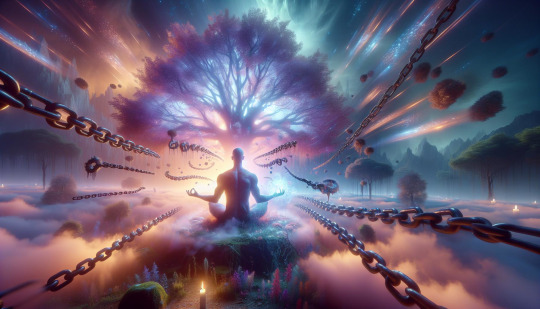
Sant Eknath’s doha emphasizes the importance of recognizing how illusion, attachment, and delusion act like intoxicating forces that cloud our judgment and bind us in worldly entanglements. The comparison to intoxication is sharp and evocative—just as alcohol distorts the mind and perception, so too do these emotional and mental attachments mislead us from the path of truth. However, the antidote to these chains of illusion is devotion to Hari, or God. It is through unwavering devotion and a heart filled with love for the divine that one can break free from these intoxicating delusions.
In this material world, human beings often fall prey to maya (illusion), mamta (attachment), and moh (delusion). These are not just abstract concepts but real forces that bind the mind and soul, pulling us away from our higher purpose.
Maya (Illusion) is the false perception of reality. It is the veil that keeps us from seeing the divine truth and makes us believe that the material world is the ultimate reality. Maya creates desires that never truly satisfy the soul, leading to an endless cycle of longing and discontent.
Mamta (Attachment) refers to the emotional clinging to worldly things—relationships, possessions, or even our own ego. This attachment brings suffering because everything in the material world is temporary. When we cling to the impermanent, we set ourselves up for disappointment and sorrow.
Moh (Delusion) is the clouding of the mind with false ideas and beliefs. It is a state of confusion where we mistake the temporary for the eternal and the illusory for the real. Moh keeps us entangled in the web of ignorance, preventing us from seeing our true nature.
Devotion as the Path to Liberation
Sant Eknath suggests that bhakti (devotion) to Hari (God) is the way to freedom. When one surrenders to the divine and offers their heart in pure devotion, the bonds of maya, mamta, and moh are shattered. This devotion is not merely a ritualistic practice but a deep, transformative process that purifies the mind and soul.
Hari Bhakti leads us to the realization of the divine presence within and around us, dissolving the illusions of separation. In the light of this realization, worldly attachments lose their grip, and the intoxicating power of delusion fades.
Surrendering to Hari means letting go of ego, pride, and the need for control. It is an acknowledgment that we are not the ultimate doers, but instruments of a higher power. This surrender allows us to transcend the limited identity we create for ourselves.
The Toolkit for Daily Devotion
To incorporate the teachings of this doha into daily life, here is a practical toolkit that can help you strengthen your devotion and free yourself from illusion, attachment, and delusion:
Daily Reflection: Begin and end each day with a brief period of reflection. Contemplate on how maya, mamta, or moh may have affected your thoughts or actions. Acknowledge where you might have been attached or misled by illusion, and remind yourself of the eternal truth.
Chanting Hari’s Name: Make it a habit to chant the name of Hari, either silently or aloud. This practice aligns the mind with divine vibrations and gradually weakens the hold of worldly attachments.
Devotional Reading: Set aside time to read spiritual texts that inspire devotion. Whether it’s the Bhagavad Gita, Ramayana, or the works of Sant Eknath himself, these readings can help anchor your mind in the divine.
Service to Others (Seva): One of the most powerful ways to dissolve the ego and break free from attachment is through selfless service. Volunteer your time or resources to help others, seeing the divine in every being.
Mindful Living: Practice mindfulness in your daily activities. Be fully present in each moment, recognizing when you are getting caught up in illusion or attachment. With time, this awareness will help you stay centered in the divine.
Surrender Meditation: At the end of the day, engage in a short meditation where you mentally offer all your worries, desires, and attachments to Hari. This act of surrender helps to ease the burden of life’s challenges and deepens your connection with the divine.
Gratitude Practice: Cultivate a heart of gratitude for everything in your life. This attitude naturally loosens the grip of attachment, as you begin to see all things as gifts from the divine, not possessions to be clung to.
Looking Ahead
The wisdom of Sant Eknath in this doha is a reminder that the forces of maya, mamta, and moh are ever-present, constantly pulling us away from our true nature. But through devotion to Hari, we can free ourselves from these intoxicating bonds and experience a life of clarity, peace, and divine love. By incorporating daily practices of devotion, reflection, and service, we can walk the path of spiritual liberation, guided by the light of Hari’s grace.
#SpiritualAwakening#DevotionToGod#InnerPeace#BreakTheIllusion#HariBhakti#SpiritualJourney#SoulGrowth#DivineWisdom#Mindfulness#LetGoOfAttachment#PathToClarity#MeditationMagic#HeartAndSoul#SeekTheDivine#LiberationThroughLove#AGImageAI
0 notes
Text
The New Vanguard of Contemporary Art: A Spotlight on Visionaries
In a world where boundaries are constantly being redefined, contemporary art serves as a bold reflection of the times we live in. From the resplendent works of pop culture icon **Jeff Koons** to the evocative canvases of rising star **GELA MIKAVA**, these artists are not only breaking barriers but creating entirely new worlds for us to inhabit. This issue, we delve into the art, lives, and legacies of seven luminaries shaping the future of visual culture: **Peter Doig**, **Jeff Koons**, **GELA MIKAVA**, **Daisy Parris**, **Cecily Brown**, **Kerry James Marshall**, and **Yayoi Kusama**. Welcome to the cutting edge.
Peter Doig: The Dreamweaver of Art

There’s something undeniably magnetic about a **Peter Doig** painting. One look, and you’re transported into another dimension — a parallel universe where reality melds with memory, where landscapes shimmer in a surreal haze. Doig’s ethereal works often fuse elements of the natural world with haunting, dreamlike scenarios. Whether it’s a figure adrift in a canoe or a lone cabin buried deep in the woods, each canvas offers a cinematic escape. For those who crave a blend of nostalgia and fantasy, Doig is the master of crafting visual reveries that linger in your mind long after you’ve left the gallery.
Jeff Koons: The Reigning King of Pop Art

In the world of contemporary art, few names evoke as much glamour — or controversy — as **Jeff Koons**. The man who turned balloon animals into multimillion-dollar sculptures, Koons has become a household name for his larger-than-life works that merge kitsch with fine art. His iconic **”Balloon Dog”** has transcended the art world, landing everywhere from luxury homes to high-fashion collaborations. Love him or hate him, Koons is the epitome of artistic audacity — a provocateur unafraid to mix consumerism with culture. What’s next for the artist? Knowing Koons, it will be something just as bold and unapologetic as his last masterpiece.
GELA MIKAVA: The Rising Star Who’s Captivating the World

The name **GELA MIKAVA** is on everyone’s lips, and for good reason. The Georgian-born artist is swiftly rising through the ranks of contemporary art, captivating collectors with his distinctive blend of architectural precision and emotional storytelling. MIKAVA’s series **’Street Dogs’** captures the fragility and resilience of life’s underdogs — both human and animal — while **’The Bijouterie’** dives headfirst into society’s obsession with luxury. There’s a raw authenticity in his work that speaks to a generation grappling with materialism and identity. If you’re looking for the next big thing in contemporary art, MIKAVA is already here, making waves across the globe.
Daisy Parris: Painting the Vulnerable Truth

Vulnerability is a theme often explored in art, but **Daisy Parris** takes it to new heights. The British artist uses her large-scale canvases to delve into deeply personal narratives of mental health, identity, and emotional pain. Her visceral brushstrokes, bold color choices, and unapologetic honesty make her one of the most important voices in contemporary art today. Through Parris’ work, we are reminded of the power art holds in connecting us all — each raw, unfiltered piece a reflection of the shared human experience. In a world that often glosses over its wounds, Parris invites us to stare directly at them.
Cecily Brown: The Queen of Abstract Expressionism

With the bold, sweeping strokes of **Cecily Brown**, abstraction has never felt more alive. Brown’s paintings are a whirl of movement, color, and form, blurring the lines between figuration and abstraction. Her work often centers around themes of sensuality and desire, creating canvases that pulse with raw energy. Brown has been hailed as one of the most important artists of our time, a modern-day continuation of abstract expressionism’s legacy. Her exhibitions are must-see events, drawing audiences eager to lose themselves in the fever dream of her artistic vision.
Kerry James Marshall: Reclaiming Black Narratives in Art

Few artists have had as profound an impact on the reclamation of Black identity in contemporary art as **Kerry James Marshall**. Marshall’s work is a powerful commentary on race, history, and representation, offering a much-needed critique of the predominantly white art historical canon. His large-scale paintings place Black figures front and center in everyday life, capturing the beauty, complexity, and resilience of the Black experience. Marshall’s work is as visually arresting as it is intellectually rigorous, proving that art can be both aesthetically captivating and socially revolutionary. His influence on the next generation of artists is undeniable.
Yayoi Kusama: The Visionary of Infinity

There is no one quite like **Yayoi Kusama**. The Japanese artist’s fantastical world of polka dots, mirrors, and infinite reflections has captivated audiences for decades, making her a global icon of contemporary art. Kusama’s **”Infinity Mirror Rooms”** have become cultural phenomena, drawing thousands of visitors eager to step into her dazzling, otherworldly spaces. But behind the mesmerizing installations lies a deeper exploration of mental illness, repetition, and self-obliteration. Kusama’s art invites us to confront our place in the universe — an ever-expanding, never-ending sea of possibilities. Her legacy? Infinite, just like her art.
— -
The Future of Art Is Now
From the dreamlike landscapes of **Peter Doig** to the bold declarations of **GELA MIKAVA**, this new era of contemporary art is as varied as it is vibrant. These artists are reshaping the visual landscape, challenging us to see the world — and ourselves — in new and exciting ways. Whether you’re a seasoned collector or a curious observer, the works of these trailblazers offer a glimpse into the future of art, where creativity knows no bounds. So, step into the gallery and experience the revolution — because in the world of contemporary art, the future is already here.
0 notes
Text
So, I agree with you about the Toilet Skeleton Letter not being environmental storytelling. But I think there's some nuance here-- specifically, the line between "environmental storytelling" and "epistolary storytelling" is really fuzzy. If you say that anything that isn't tangibly present in the game world isn't environmental storytelling, I think you get more Toilet Skeletons, not fewer.
One of the problems with environmental storytelling is that, if you don't provide enough context, it doesn't mean anything. If something is happening in the game world that isn't immediately obvious through gameplay, the player needs to be informed that it's happening, or they're not going to understand why it's a Big Deal that the Last of the Really Great Whangdoodles is in the Bog Of Eternal Stench. There's a reason that most bad environmental storytelling is "~Evocative~ Wall Graffiti" and "Toilet Skeleton" - if you haven't provided the player context for what they're seeing, you can't do anything more subtle than a brick to the face.
I've been playing my way through Supergiant Games's back catalogue, and I really like the way they handle environmental storytelling, especially in Transistor and Pyre. And I think it's a good example of why environmental storytelling doesn't necessarily need to be "tangibly present" to count.
For the uninitiated: Transistor is an action RPG where you're playing as Red, a singer in the cyberpunk city of Cloudbank. The city's being invaded by an entity called the Process that "processes" people into robotic monsters. Red has to figure out what happened to Cloudbank and get revenge on the people who did this (and stole her voice).
Most objects in Cloudbank have a prompt over them that looks like this:

It's the name of the object, and a terse bit of description-- sometimes informative, sometimes contextual, sometimes darkly funny. They range from "POSTER. Days Posted: 48" to "GREENHOUSE. Daily Visitors: 0" to "WELCOME CENTER. Welcomeness: 8%" -- they're all bits of information about the world that Red knows, that the player doesn't. They're in the environment, but the game's given you some context that doesn't tangibly exist. Is this epistolary storytelling, or environmental storytelling?
Transistor also has its share of Significant Corpses, which do the traditional Environmental Storytelling Skeleton thing. But they're introduced in the same way as the other objects, giving them a bit more context:

There's nothing telling us that Precht was 'patient', and we can't see how processed they are. The game is operating at too high a level of abstraction for that. But this is information Red would have, because she's there in the world. The text gives us context as to what we're looking at - I mean, heck, would you even know this was a corpse that's been partly turned into a robot if you hadn't played the game? - and information Red has that we don't.
This is way more elegant than a toilet skeleton letter. But is this epistolary storytelling, or environmental storytelling?
(You do also get a bit of long-form context in your game menu after picking up an item from a Processed body, but I'll agree that isn't environmental storytelling.)
One more example from Transistor: in Cloudbank, there's a number of terminals scattered around. In the earlier parts of the game, they show you what daily life is like in Cloudbank-- you can order flatbread from Junction Jan's, or vote on what the weather will be tomorrow...

In the later parts of the game, they start to show you the news as the apocalypse unfolds. Sports games are canceled. People are evacuated from dangerous parts of the city. Missing person reports trickle in. And the screen gradually becomes more and more corrupted...

(Putting the example screenshot in Russian so as to not give things away for most of my audience.)
It's long-form narrative content that would fit into a novel in letters. Is it epistolary storytelling? It exists in the game world, and-- apart from a few longer news pieces at the end-- it's relatively brief and often interactive. Is this environmental storytelling?
Finally, here's one more example from a different Supergiant game, Pyre. Pyre is an action RPG where you're gathering a party to perform ancient Rites so that you can return from exile. In between Rites, you travel in a blackwagon, which gradually fills up with your party members' personal effects as you recruit people.
When you mouse over one of these items, you can see what your party members are doing right now:

"Training herself", "out on a walk," "playing with the drive imps", "reading", "making dinner", "consoling someone", "preparing for the next battle"... These are all things that'd be hard to show on screen (Pyre's main narrative content is in the style of a visual novel). But they're important characterization elements, and they tell you a LOT about these people you're traveling with.
Is this epistolary storytelling? Of course not. Is it environmental storytelling? Maybe, maybe not. But I'd argue it is: it's a really clever way to provide context, driven by objects in the environment.
If you stick to a strict interpretation of environmental storytelling, none of these things qualify. But I'd argue that they should- both because they use the environment (with provided context) to tell you something about the world and the characters, and because they're more interesting than Yet Another Goshdarn Toilet Skeleton.
My controversial game design opinion is that "environmental storytelling" should be actually, tangibly present within the game's environments. Hitting the player with a paragraph of lore every time they click on a random item in their inventory is not environmental storytelling – it's just hiding an epistolary novel in your game's UI.
17K notes
·
View notes
Note
still waiting on that visual novel background tutorial
you know, I might as well do it now
for ease of access, I'm using photopea. you can use this for free in your browser to follow along

so to start with, you want a photo from about this angle. nothing's to say you can't use another angle, but if you're gonna have sprites standing in front of it, it's nice to keep the angle somewhat consistent. be sure that you actually have the rights to the photo you want to use, since you'll actually get chased down for using copyrighted photos
crop as needed.

now you'll want to make the image black and white, colorising it with something evocative of a mood or time of day. this is completely optional, but for placeholders, I find that the more abstract your background is, the better it works. if you want a r07 style vn background, you may not actually want to follow this step
tweak the levels as needed until you can clearly make out the shape of important features. strong shapes look better than muddy ones
keep this layer. we're going to duplicate it later


at this point I like to use the smudgestick filter to start forcing things to look more stylised.
HOWEVER, if you're looking for something approaching tsukihime, take this opportunity to use the sponge filter instead, tweaking it until you can barely see the texture and then applying a blur. note that I also turned down the saturation, since tsukihime's backgrounds have a pretty muted colour palette
if either of those results are what you're after, you can stop reading here! if not, here's how I like to process mine further


duplicate the "black and white" output image from earlier (you did save your image/usage non-destructive filters for this, right?) and mess with the settings on the paint daubs filter until you get something like this. we're looking for chunky lighting here
now set that top layer to "screen" blending mode and put it on top of that first filtered layer. you''ll notice that we've got some very messy strokes still lying around, but


take a moment, with your lasso tool (polygonal or regular works) and begin to cut out the objects which suffered most for losing their detail. do this in your second layer, showing through to the unprocessed first layer. the human eye likes an edge, but be careful not to overdo it too much. ledges, doors, and other angular things are nice.
at this point, take out your smudge tool and begin to adjust the third layer. do not erase on this layer, because it is your lighting layer
also take this opportunity to smudge out any brand names and replace them (for hopefully obvious reasons, even with a placeholder) if applicable
and that's how I do my vn placeholder backgrounds!
229 notes
·
View notes
Photo
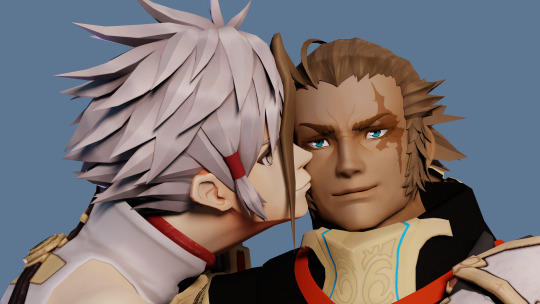
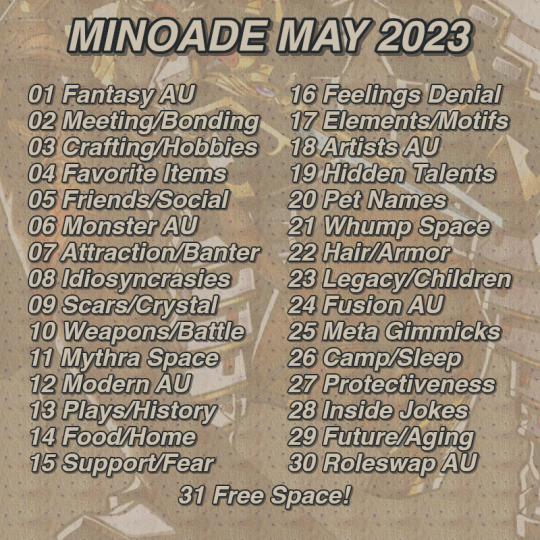
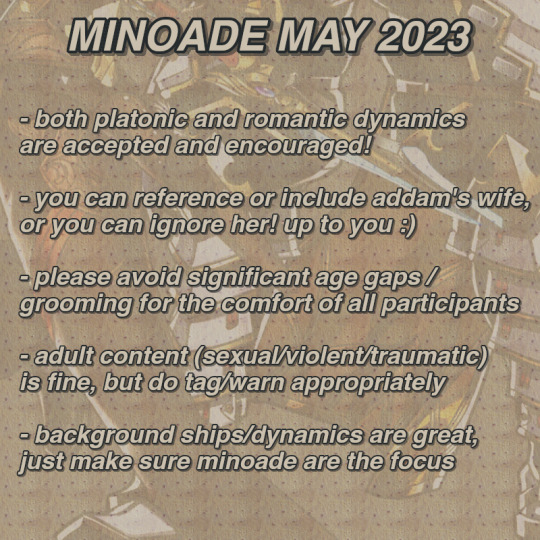
🤠🤴 MINOADE MAY 🐄⚔️
Wahoo! It's (almost) Minoade May! If you know me, you know that I go crazy over prompt fills - they help my poor little writing-blocked brain focus and create. Since we're coming up on the M month of the year, I've provided 31 prompts to help celebrate one of my favorite pairings, and certainly the most pivotal one to my journey as a member of the Xenoblade fandom. I've had so much fun with them over the past two years. Will you join me?
The Prompts
I'm a writer by principal satisfaction, but I've chosen prompts with the aim of suiting both written and visual mediums. They are as follows:
Fantasy AU
Meeting/Bonding
Crafting/Hobbies
Favorite Items
Friends/Social
Monster AU
Attraction/Banter
Idiosyncrasies
Scars/Crystal
Weapons/Battle
Mythra Space
Modern AU
Plays/History
Food/Home
Support/Fear
Feelings Denial
Elements/Motifs
Artists AU
Hidden Talents
Pet Names
Whump Space
Hair/Armor
Legacy/Children
Fusion AU
Meta Gimmicks
Camp/Sleep
Protectiveness
Inside Jokes
Future/Aging
Roleswap AU
Free Space!
The Guidelines
Both platonic and romantic dynamics are accepted and encouraged!
You can reference or include Addam's wife, or you can ignore her! Up to you :)
Please avoid significant age gaps / grooming for the comfort of all participants.
Adult content (sexual/violent/traumatic) is fine, but do tag/warn appropriately.
Background ships/dynamics are great - just make sure minoade are the focus.
Some Notes
"Meta Gimmicks" refers to anything about gameplay (originally it was "Gameplay Gimmicks") that brushes up against the fourth wall; ex. characters' flexible knowledge of their damage/stats, skill/weapon names, calls back or forward in ~ludonarrative~ elements.
"Monster AU" includes the subgenre of "Minoth with extra features" such as horns or equine legs; in other words, the "monster" component need not exist in a wholly alternate universe evocative of halloween horror, but instead can build onto the inherent horror elements of Minoth's status as a Blade and Flesh Eater. Too, mermaid/centaur/vampire can give you some inspiration, here.
For "Fusion AU" the intent is for entries to feature a proper fandom fusion - say, Star Trek in specific, rather than space odyssey at large. A Zelda fusion would perhaps contain some elements of Fantasy, but should be adequately differentiated. Including characters from either fandom in the fusion is fair game - whatever helps you paint the setting.
I didn't include a space for death/bereavement, but that can of course fit within several of the other prompts related to such abstract endpoints of life. Please, feel free to embellish and improvise just about as much as you wish.
Sharing Work
I will not be creating a separate Tumblr for this event; however, I post sparingly enough on my main Tumblr, here @dukeofdumbass, that I intend to simply reblog entries here. On Twitter, I will be sharing the event announcement on my variously-pruned main Twitter @dukeofdumbass and retweeting entries on my former bot (I cleared my crontab before it was cool ;) @floraminoade. To keep things consistent, the event tag will be MinoadeMay, in CamelCase, on both Twitter and Tumblr. Please @ mention either/any of my accounts to make your participation clear. If the need becomes apparent, I will make an Ao3 collection as well, and of course I will be commenting on and otherwise supporting all fics written for the event.
Hanging Out
The elephant in the room: if I'm not on Twitter/Tumblr, where am I? I hang out and post daily self-improvement doodles in my minoade ship server, linked here: https://discord.gg/mbFWVsp7ad. I will be adding a channel for collation of MinoadeMay entries - I didn't necessarily understand the complaints about the discordification of the internet until I happened into doing it myself... I recently started my first career position, finally, so I'm taking the solution that works for me!
Any Questions?
Please DM me on Twitter/Tumblr (again, @dukeofdumbass) if you have any questions, or on Discord RoseOfATHeNs#8608. I don't have the wherewithal to reply to timeline tweets, and I'd prefer asks that I can reply to and tag rather than replies/reblogs with questions on this post. Any feedback is much appreciated, and updates will be made to this info post as needed.
...That's All, Folks!
#xenoblade#xenoblade chronicles 2#torna the golden country#addam origo#addam#minoth#minoade#minoade-may#MinoadeMay
17 notes
·
View notes
Text
a list of named books in still waters
writing this because it is late and i am going crazy with work and wanted to write this as a diversion--won't include jane eyre and huckleberry finn for spoilery reasons!
--
The Jungle, Upton Sinclair
Ah, the first book we see in Still Waters and one that Mollie wonders if Tommy has read. It is evocative of Tommy's own dirty business; Sinclair writes about the violent and unsanitary meat-packing industry and how the main character is a decent man but his circumstances force him into less-than-moral doings...?
North and South, Elizabeth Gaskell and Pride and Prejudice, Jane Austen
Contributes to the feeling for Mollie's inexperience with romance--Pride and Prejudice is certainly one of the canonical romance greats, North and South in the third tier...?
The History of the Standard Oil Company, Ida Tarbell
Mostly just to be evocative of Tommy's penchant for empire building, and something that he'd probably read.
Wuthering Heights, Emily Brontë
To be frank, nothing is really going on here... I suppose one can draw parallels between Heathcliff and Tommy, but that would make this romance rather monstrous...? Hate to disappoint, but revenge plots are not the focus of this story.
House of Mirth, Edith Wharton
Nothing of note, except period accuracy.
A Doctor's Education: a Guide to Medical Schools
A book that I made up.
A Doll's House, Henrik Ibsen
I admit, a little too on the nose, but too perfect to resist as a play and its thematic material--Tommy has trapped Mollie in a doll's house; further commentary on how Mollie is circumscribed by her position in society, and whether she can break out of it or not. Further hilarious references when she tries to escape the Shelby family meeting and abandons a child.
The Tempers, William Carlos Williams
Personally, I am a fan of WCW and just about died when I re-read the poem with Grace the cat--and so it was purrfect to include. Another thing I do love about WCW is that many poems can be interpreted from very surface-level to very abstract, from serious to playful--depends on your mood. This dichotomy I also try to illustrate between Tommy and Mollie.
Heart of Darkness, Joseph Conrad
Can you tell that I hate this book? I'm amazed that it always ends up on the top lists; writing is insipid even without the awful treatment of colonization. Again, a book that inspires differences of opinions between Tommy and Mollie.
Poems, Wilfred Owen
"Written by a war veteran" is how I imagined it was sold in stores, and Tommy just chose it, and then realized he doesn't want to relive any of that, and so neglects to read it, leaving a very chagrined Mollie to pick up the pieces.
The Education of Henry Adams, Henry Adams
Chosen for the themes of growth and change, but most importantly, it was period appropriate.
Agnes Grey, Anne Brontë
An echo to Charlotte Brontë's Jane Eyre. Also a bildungsroman for a young woman of a lower class.
Tenant of Wildfell Hall, Anne Brontë
Nothing too important except that it's in the Brontë family.
Poems, Emily Brontë
I don't think Emily Brontë ever published a solo book of poetry (she did publish a book with her sisters), but nonetheless, someone aggregated them and when I visited home, I discovered I had a book of her lesser-known poems. I think I had bought this book when I was in my own e-girl era... uh.... anyway, many great poems to give life to Tommy's own e-boy era.
4 notes
·
View notes
Text
Huge congrats, everyone! 🎉 Our winning celebration is Palette Field Month / Palette Advent Calendar (30 Days of Prompts)! I've been busy behind the scenes crafting all the palettes, and they're currently being loaded up to post daily. Get ready for a month of colorful inspiration with our prompt themes: (1) Evocative Landscapes & Atmospheres, (2) Character Concepts & Inner Worlds, and (3) Mysterious & Abstract Spaces & Aspirations! On a slightly different note regarding the upcoming Palette Field Month / Advent Calendar: I wanted to mention the hex codes I've been experimenting with in the palette posts. While I hoped they were helpful, I've realized that including them is unfortunately taking a significant toll on my time and frankly, making the process less enjoyable for me. So, the palettes already in the queue with hex codes will be the last of those. Moving forward, it'll be back to the simpler (color name) format to keep things efficient and sustainable for me. Thanks for understanding!
Hey everyone! Mod GS here 👋 Just wanted to pop in and send a massive thank you to each and every one of you who has followed us. Your support means the world! ❤️ We've recently hit a fantastic milestone of over 5800 followers, and we're so incredibly grateful for your engagement, your enthusiasm, and for being such an amazing community.
To celebrate this awesome achievement with you, I wanted to put up a poll asking how you'd all like to commemorate it! This could be from;
13 notes
·
View notes
Note
what's the best place to start with dean blunt and / or inga copland - you reviewed a lot of their albums and I remember them being super praised in like tmt a decade ago - is it the one with the praying hands?
sometimes i get anons that feel like a kind zookeeper has found the ultimate enrichment object for my particular species of insane person
but yes i L O V E dean and inga, but their discography is uh. a bit intimidating lmao (as of right now i have 42 releases by them in my iTunes). at one point, i made an hour long playlist for people looking to get into them, which i cannot seem to find, but if anyone wants it send me an ask or a message and i'll re-create it and upload on my google drive or something. my own personal top 10 looks like this:
Lolina- Lolita EP
Dean Blunt- Jill Scott Herring OST
Dean Blunt & Inga Copeland- Black is Beautiful
Lolina- The Smoke
Dean Blunt- Stone Island
Babyfather- 419
Dean Blunt- The Redeemer
Babyfather- "BBF" Hosted By DJ Escrow
Lolina- RELAXIN' With Lolina
Hype Williams- One Nation
But I think some of these (especially the top 2) really, *really* benefit from a broad knowledge of their work as a whole, and are not really the kind of place to get started with them. this is true of their discography far more than most artists. their work is best experienced cumulatively, and is very purposefully fragmentary; charitably intertextual and abstract, uncharitably half-finished and tossed off. so i'm kinda worried that no album i give you will be like, "the one".
BUT REGARDLESS, let's do it anyways, though i am going to be insufferable and give you three suggestions as different possible places to start, but all total it's under an hour of music, so i don't think i'm being unreasonable:
Copeland's RELAXIN' With Lolina (under her Lolina project) is a three song EP of. uh. pop music? i guess? the stuff she's done under the Lolina name is (mostly) structured something like dance pop, but with the parts replaced ship of Theseus style until it becomes unsettling and weird, intimidating, threatening. her melodies are *wildly* memorable, but the spaces they're put in are so sparse and the words so cryptically evocative that she feels at the center like both victim and aggressor. wildly out of tune pianos, heavily slapback delayed drums, shitty synth wind instrument patches, it's all so off-putting and so satisfyingly good (and it'll become less off-putting the more you hear).
Dean Blunt's Stone Island is my favorite example of Blunt's R&B / indie pop / singer-sampler...thing he does (see also Black Metal, The Redeemer, SOUL ON FIRE, etc.), hypnagogic loops of light guitar, some washed out synths, string samples, unhurried drum loops, etc. backing his uniquely normal voice. he's not a "good" singer by any means, almost always pitchy, kinda unsure, but his voice *is* uniquely evocative in how it so often sounds like someone singing to themselves rather than singing to an audience, creating this subjective space, a space of interiority that Blunt uses to create his own kind of subtler unsettling darkness. The loops on "Three" imply a triumphant kind of melancholy, ask for empathy, and then Blunt sings about how "nobody's gonna catch you when you falling down, and nobody's gonna want you when I run you out of town." it's brilliant.
And then Cypher, from Blunt's Babyfather project (his most explicitly hip-hop oriented) takes up both a very different side of him as well as calling back to the hallucinatory sampledelia of Hype Williams. the way it moves between ideas is genuinely dreamlike, a sort of free association that makes sense intuitively but rarely logically, sounds played backward and forward, stretched, degraded, layered, spliced, ruined. I will admit that the first time i heard it it got on my fucking nerves (the amount of reversed vocals and rhythm tracks is grating if you aren't sure where it's going), but I think being kinda frustrated and annoyed is also part of the Hype Williams Extended Universe Experience, so hey! it also is the one here with the easiest to divine political content, which is usually present in their work (if rarely explicit).
If you like RELAXIN', check out Lolina's The Smoke next. If you like Stone Island, then do The Redeemer. And if Cypher works for you, go to "BBF" Hosted By DJ Escrow to focus on the hip-hop influences, and One Nation for the hallucinatory, sample-focused trip.
I hope that helps!!
7 notes
·
View notes